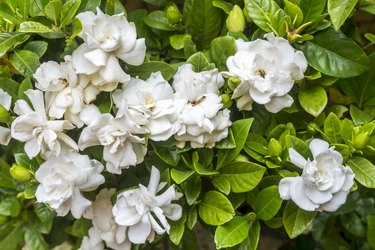
Growing gardenias (Gardenia jasminoides, USDA zones 7-11) can feel like a significant achievement for both novice and professional growers alike, which is why any sign of something harming your garden babies can feel like a huge deal. If you start to notice white fungus on your gardenias, you're most likely dealing with a case of powdery mildew.
Tip
Powdery mildew is a white fungus that you can find on gardenias and other plants. This fungus generally won't kill your plants, although severe infestations can weaken plants and impair their ability to photosynthesize.
Video of the Day
What Is Powdery Mildew?
Erysiphe polygoni is one of the many fungal pathogens that can cause powdery mildew on gardenias. The fungus is mostly located on the upper leaf surfaces, but it can also be found on the undersides of leaves. You'll be able to spot symptoms of infection easily because a whitish- to grayish-colored powdery fungal growth will show up in patches or spots. Sometimes, these patches or spots can overtake the entire leaf or other plant parts.
Video of the Day
Gardenias can become susceptible to powdery mildew in the summer, and infection peaks in late summer. Although the spots or patches of powdery mildew may appear white to grayish, the fungal growth can darken. When the fungal growth darkens, you may also see the formation of small, rounded reproductive structures called cleistothecia.
Cleistothecia start as pinhead-sized, rounded structures. These structures are initially whitish, and then they darken to yellow-brown. Eventually, the color turns to brown or black. Powdery mildew forms when plant foliage is dry, when there's low lighting and when temperatures are moderate. Powdery mildew also forms when there is high humidity.
Is Powdery Mildew Dangerous?
If your gardenias get powdery mildew, it's generally not fatal. Unfortunately, though, it can hurt the overall aesthetics of your gardenias. In severe infestations, powdery mildew can inhibit photosynthesis, robbing plants of their ability to produce food. When powdery mildew isn't treated, it will leach nutrients from your plants. The major effects will be noticed on the gardenias' young leaves and shoots. You'll also see deformed leaves and buds, leaf yellowing and leaf drop.
Preventing Powdery Mildew
The best way to ensure your gardenias don't get powdery mildew is through prevention. When planting gardenias, make sure there is enough room between your plants so that there's adequate airflow around them. When you plant your gardenias, make sure that they are planted in an area with enough light. Also, check to see that your soil can drain adequately.
When growing gardenias, they need to be properly maintained. Powdery mildew spores can spread, so as soon as you notice powdery mildew on your gardenias, treat the fungus and always remove dead gardenia parts. Another option is using preventive treatments, like a fungicide, so powdery mildew doesn't form at all.
Treating Powdery Mildew
If powdery mildew does form on your gardenias, you can use an organic fungicide to treat the fungus, and you can try using milk as well. All of the science isn't yet known, but some studies point to milk as a popular treatment due to its compounds. It should be noted that milk is not an approved fungicide, but because it's nontoxic and not harmful to plants, you may want to give it a try.
Milk appears to work by providing nutrients on leaf surfaces for benign microorganisms, which reduces the surface area on leaves for powdery mildew to form.
Mix 1 part milk to 2 or 3 parts water. Spray the milk mixture on the powdery mildew and around the plant as well. Repeat weekly to keep your leaves free of fungus.